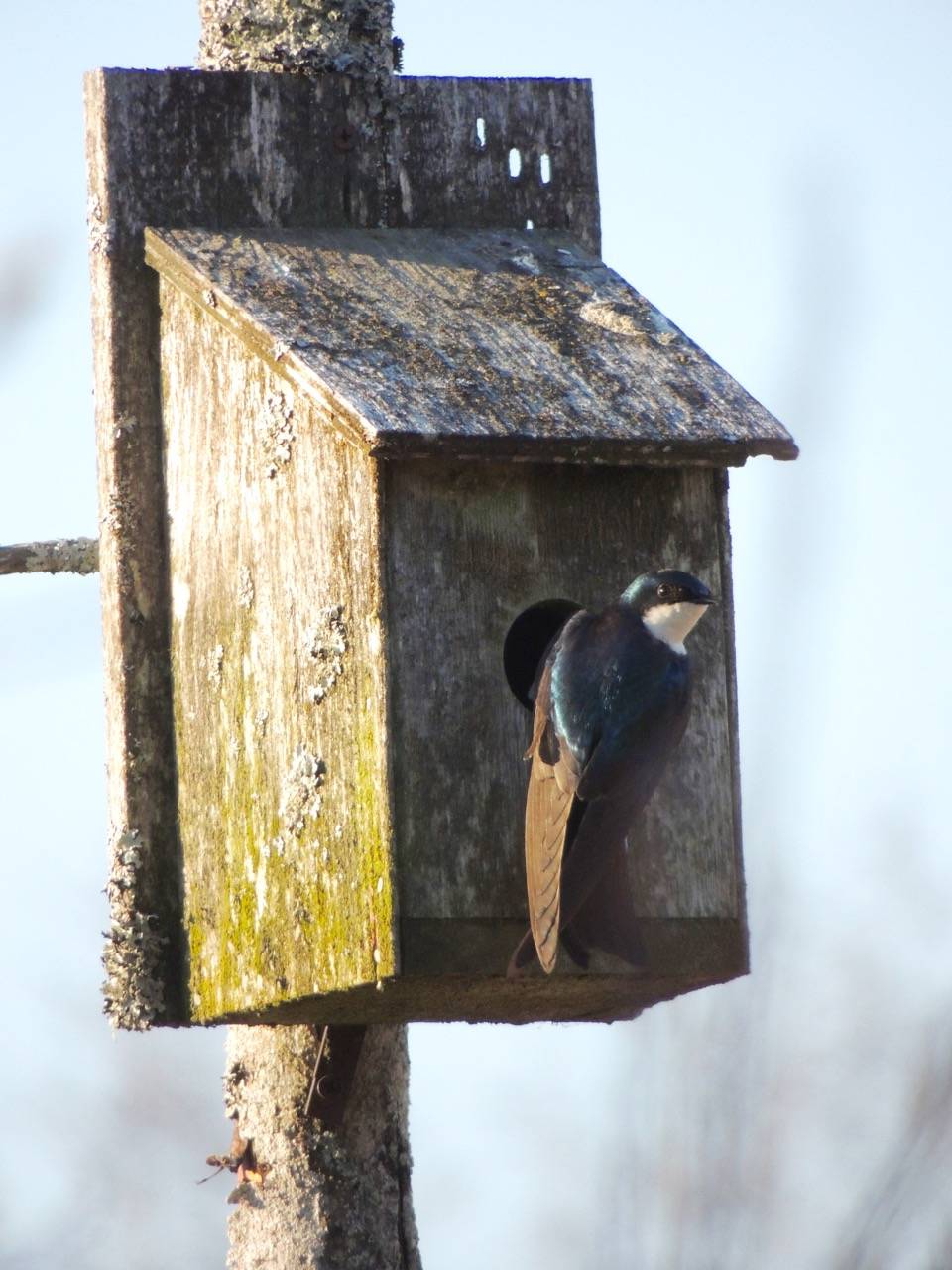Birds are usually very choosy about where to put their nests. Some species prefer a site right next to a tree trunk where the nest is supported by small side branches, while others favor the ends of long branches. Some like cavities in trees or ledges on cliffs; others choose an upright branch-fork in a shrub or a sheltered nook on the ground under a grass tussock.
Because birds are so often choosy about their nest sites, there can be fierce competition among birds of the same species —each female wanting a certain configuration of vegetation or micro-landscape or topography. This may help explain why sometimes there are oddballs that avoid conflict by selecting unusual choices, such as Mrs. Phoebe who selected the top of the lamp by our back door in Wisconsin for her nest (of course obliging us to use another door until she was finished raising her chicks).
In some cases, a limited number of suitable nest sites may affect the distribution or population size of certain species. For example, this is likely to be true for American Dippers in Southeast Alaska. Dippers nest on cliffs (sometimes bridges) along suitable mountain streams, and we have sometimes observed prolonged battles between dippers that wanted to nest on the same cliff; the loser had to look elsewhere. Furthermore, studies in British Columbia have indicated that intense competition for nest sites along productive low-elevation streams probably force less competitive dippers to nest at less productive, higher elevations where fewer chicks can be raised.
Sometimes different species have overlapping nest-site preferences, and they may compete intensely for favored sites. For example, my Wisconsin nest boxes designed expressly for eastern bluebirds also appealed to tree swallows, which often commandeered a box initially chosen by bluebirds; flying squirrels sometimes occupied those boxes too, limiting the availability for bluebirds. Here in Southeast, a nest box selected by chestnut-backed chickadees can be usurped by tree swallows, even after the chickadees have finished building a fine nest — and even laid eggs — in the box. A small entrance hole (slightly more than one inch in diameter), just big enough for the chickadees, would help keep out the swallows. Information on building nest boxes of suitable dimensions for various species, with specifications about the size of entrances, can be found online.
Although birds that make open-cup nests can be highly selective of nest sites, cavity-nesters probably have more limitations of available nest sites, unless they make their own cavities. Woodpeckers, of course, excavate their own nest cavities in trees; bank swallows and kingfishers dig their nest holes in dirt banks. Although chickadees and nuthatches can excavate in soft, rotting wood, they commonly use existing cavities or, in the case of chickadees, nest boxes.
However, other cavity-nesting birds do not make their own excavations. Some birds, such as barred owls and northern hawk owls, often nest in natural cavities in snags and in trees with broken tops or torn-off branches but, upon occasion, use abandoned stick nests of crows or hawks (or, rarely, nest boxes). Violet-green swallows need cavities, but they may have some flexibility — the holes can be in trees, or cliffs or nest boxes. Tree swallows commonly nest in tree cavities, such as abandoned woodpecker holes, but their ready use of nest boxes and observed habit of evicting previous owners suggests that natural nest sites may be limited for this species. I once watched a female tree swallow persistently trying to enter the tail pipe of an automobile exhaust system, suggesting that she had found nothing better and was considering that totally unsuitable place as a potential nest site.
Some of the ducks that occasionally nest in Southeast use existing cavities: hooded and common merganser, bufflehead and common goldeneye. Wood ducks, which are seen in some of the ponds in the Mendenhall Valley, typically nest in cavities and will use nest boxes, but I have not heard if they actually nest here. Sometimes these tree-nesting ducks choose cavities well above the ground, so that the chicks have to flutter a long way down to the ground to follow their mothers to feeding areas.
The small owls that reside in Southeast characteristically nest in tree-holes with larger openings than those used by swallows and chickadees. The desirable size of the cavity entrance is likely to be similar for saw-whet, boreal, western screech and pygmy owls, so it seems possible that these species might compete for sites in some places. They might even compete with some of the small hole-nesting ducks. Where their geographic ranges overlap with those of kestrels or flickers (mostly east of the Coast Range), there sometimes is competition between the owls and those species for cavity-nest sites.
There can be advantages to nesting in cavities: Cavity nests are safer than open-cup nests and cavity-nesters typically have higher nesting success than open-cup nesting species. However, for species that depend on existing cavities, cavity nest sites may be a limited resource for which birds of different species sometimes compete.
Birds may use cavities not only for nesting but also for other purposes, such as shelter or possible sources of food. That has meant that some cavities provided by humans can attract a variety of birds. Unfortunately, the cavities offered by open vertical pipes (fence posts, vents, markers, sign posts) have proved to be death traps for thousands of birds, which enter the pipes but can not get out. Scientists and land-managers often have found dozens and even hundreds of bird carcasses piled up inside a vertical pipe. This massacre can be avoided by removing unneeded open pipes and capping or screening the remainder.
• Mary F. Willson is a retired professor of ecology. “On The Trails” appears every Friday. Her essays can be found online at onthetrailsjuneau.wordpress.com.

